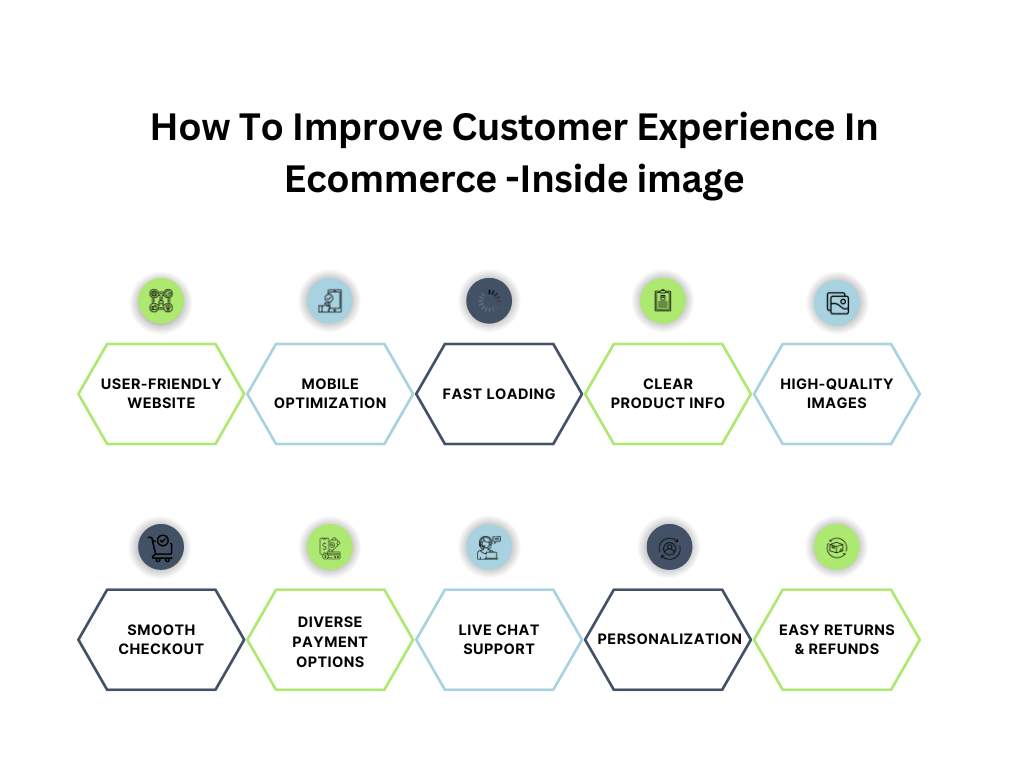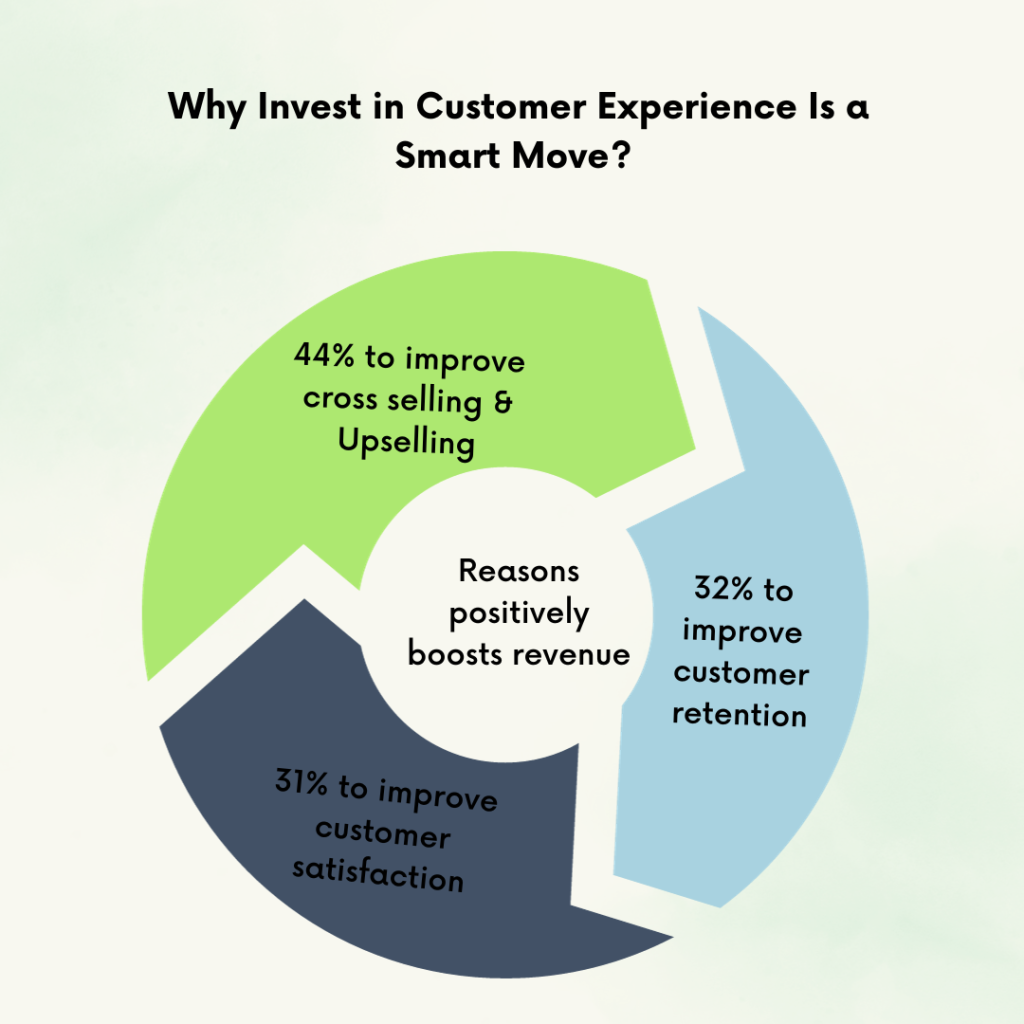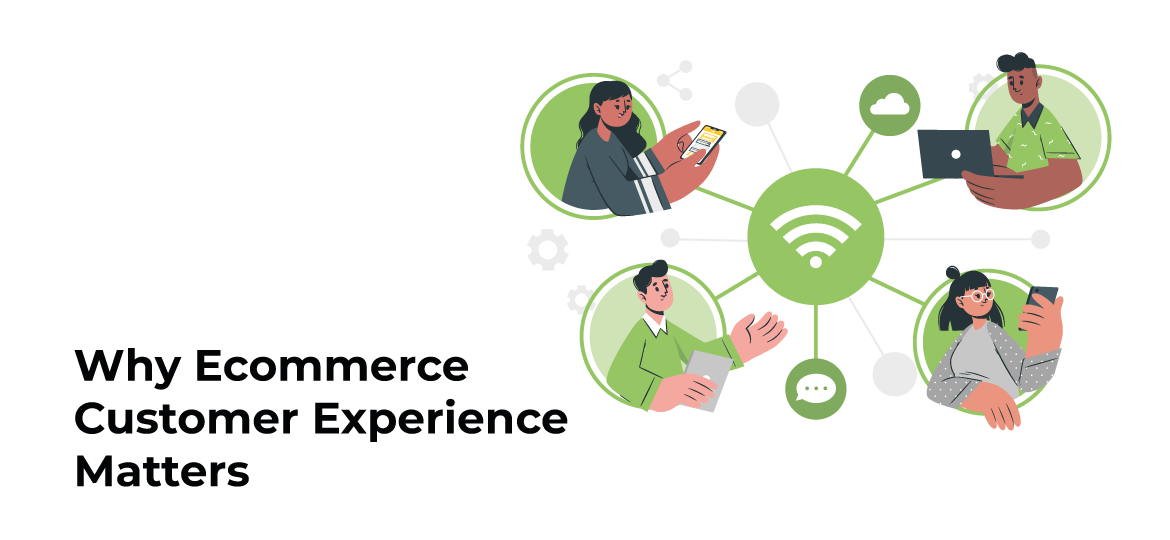The financial sector’s growing reliance on technology has made skilled banking app developers crucial for meeting customer demands, enhancing security, and driving innovation.
However, recent reports indicate that over 70% of banking executives face significant challenges in finding the right developers for their app projects. This shortage of top-tier talent, coupled with the complexity of banking app development, makes hiring a difficult task.
The pressure to modernize and maintain a competitive edge in the industry is intense, but concerns about security and the risk of project delays or disruptions due to a lack of technical expertise add to the challenge. These factors create a complicated landscape for banks seeking the best banking app developers.
Deciphering eCommerce Customer Experience
At its heart, Ecommerce customer experience is all about the complete journey a shopper goes through while engaging with an online store or brand when they’re looking to make a purchase.
This journey covers every interaction, starting from their first encounter with the brand, whether it’s on a website, mobile app, or social media, and it extends through the entire process, even after they’ve made a purchase, with the support and follow-up they receive. It’s the whole experience surrounding their Ecommerce customer journey.
Why Ecommerce Customer Experience Matters?
Ecommerce customer experience is truly the beating heart of your online business.
When you create a remarkable Ecommerce customer experience, you’re nurturing the loyalty of your customers. Just like a warm hug, it makes them feel appreciated and valued.
It’s the warm embrace you offer to your customers, and here’s why it holds such significance:
1. Happy Customers:
When your online store leaves customers satisfied, it’s not just about a single transaction. Happy online shoppers are more likely to become repeat customers, returning to your online business for their future needs. They’re also inclined to share their positive experiences with friends and family.
2. Standing Out in the Digital Marketplace:
Think of the digital world as a bustling online mall, with numerous e-commerce stores vying for attention. A stellar customer experience is like having the most inviting shop, standing out from the virtual crowd. It’s how you become the preferred destination in the vast online marketplace.
3. Boosting Sales:
While you don’t have a physical space for customers to navigate, your website’s layout and design play a similar role. An intuitive, user-friendly website design can encourage customers to explore more, add items to their cart, and complete their purchases.
4. Less Cart Abandonment:
Ever had the intention to buy something in a physical store but changed your mind and left without making the purchase? Cart abandonment in e-commerce is akin to this. An easy, hassle-free checkout process ensures customers don’t abandon their shopping carts.
5. Great Brand Image:
Your e-commerce store’s reputation matters as much as a physical store’s reputation. A positive customer experience not only leads to satisfied customers but also enhances your brand image, making customers proud to be associated with your online store.
6. Customer Loyalty:
Retaining customers is like striking gold. It’s more cost-effective to keep existing customers returning than constantly seeking new ones. A satisfied customer becomes a loyal one, ensuring a steady stream of repeat business.
7. Learning from Data:
Imagine if you could magically access a book with detailed information about each customer’s preferences and shopping behaviors. Well, in the digital realm, data provides those insights. Understanding your customers through data enables you to make informed decisions about your online store, just as you would cater to a physical store’s clientele.
8. Word of Mouth:
Happy customers become your most effective marketers. They share their positive experiences with friends, family, and their social networks, generating valuable word-of-mouth marketing for your online store.
9. Less Customer Support Hassles:
In a physical store, excellent customer service reduces the need for extensive support. Likewise, a smooth online customer experience means fewer customer inquiries and support requests, which saves both time and resources.
10. Going Global:
Just as a physical store might attract international visitors, e-commerce allows your online store to reach customers worldwide. A positive customer experience is crucial for building trust and expanding your customer base globally.
11. Adapting to Expectations:
Customer expectations evolve over time. Staying ahead of these changes is essential to remain a top choice for online shoppers. Adaptation is key to your online store’s long-term success.
12. Staying Legal and Ethical:
Similar to adhering to legal requirements in a physical store, ensuring a great customer experience while complying with online regulations and data privacy laws is vital for your e-commerce online store’s responsible and ethical operation.
In a nutshell, ecommerce customer experience is the secret sauce that makes your online business thrive. So, put your customers at the center of your universe, and you’ll see your online store flourish.
Proven Ways to Improve eCommerce Customer Experience
Let’s spruce up those tips for enhancing your e-commerce customer experience in a more conversational and original way:
A User-Friendly Hangout:
Think of your website as a cozy hangout spot for your customers.
Make it super easy to find their way around, with a design that’s a breeze to navigate, loads like a speeding bullet, and serves up all the juicy details about your products.
Mobile Magic:
In today’s mobile-centric world, it’s essential to ensure your website looks fantastic on small screens. It should be a seamless, enjoyable experience for mobile users. Offering a mobile app that’s incredibly user-friendly is like having a conversation with your customers without words; it’s an intuitive connection.
Need for Speed:
Just as in the physical world, nobody likes waiting around in the digital space. Slow-loading pages are like making your guests stand in line for too long. Optimize loading times to prevent user frustration and create a smooth, efficient experience.
Customer Sidekicks:
When customers have questions or need assistance, they shouldn’t feel like they’re hitting a brick wall. Offering responsive customer support channels, such as live chat, email, or phone, is like having friendly and helpful staff on hand in your store. Quick, attentive responses make customers feel valued and appreciated.
No Secrets, Just Truth:
Honesty is the foundation of trust. Be transparent about product availability, pricing, shipping costs, and return policies. Hidden fees or unclear information can lead to mistrust and disappointment. Clarity is like speaking honestly with your customers, and it’s essential in building a lasting relationship.
One-Click Wonder:
The checkout process should be a breeze, much like a seamless transaction at a physical cashier’s counter. Make it as quick and easy as possible, requiring minimal clicks. Multiple payment options offer flexibility, catering to the unique preferences of each customer.
Customer Cheerleaders:
Displaying customer reviews and testimonials is like showcasing trophies in your store. It builds trust and confidence in your brand. Positive feedback provides social proof and helps potential shoppers feel more secure about their choices.
Post-Purchase Love:
The shopping experience doesn’t end at the checkout; it’s an ongoing journey. Offer post-purchase services like order tracking and request for feedback. This engagement is like staying in touch with your friends, showing that you’re there for them even after the sale.
Loyalty Pays:
Loyalty programs are like throwing a special party for your most loyal friends. They encourage repeat business by offering rewards and incentives. Just as you’d give a little extra to your close friends, these programs express gratitude for ongoing support and create a strong bond between you and your customers.
By turning these practical tips into a friendly chat with your customers, you’re not just improving their experience, but also creating an eCommerce Mobile App Development paradise that they’ll want to visit again and again.

Elevating Customer Experience Through Digital Transformation
Digital transformation plays a crucial role in shaping the customer experience. As technology advances, online businesses must adapt to remain competitive. Here are key aspects of digital transformation that enhance e-commerce customer experiences:
1. Data Analytics:
The collection and analysis of customer data enable businesses to understand customer preferences, behavior, and buying patterns.
This data can then be used to personalize offerings, marketing, and the overall shopping experience.
2. Artificial Intelligence (AI):
AI-driven chatbots and virtual assistants provide real-time support, assisting customers with product inquiries, recommendations, and problem-solving.
3. Augmented Reality (AR) and Virtual Reality (VR):
These technologies allow customers to experience products in a virtual environment, such as trying on clothing or visualizing furniture in their homes.
4. Voice Search:
The increasing use of voice-activated devices like Amazon Echo and Google Home is changing the way customers search for and purchase products online.
5. Enhanced Payment Methods:
Digital transformation has brought about secure and convenient payment options, including digital wallets, contactless payments, and cryptocurrencies.
Also Read:
eCommerce Personalization: Creating an Engaging Customer Experience
Personalization stands as a powerful ally in the realm of e-commerce, poised to transform and enhance the customer experience. At its core, personalization means crafting the shopping journey to align with the unique preferences and behaviors of individual customers. It’s about making each visit to your online store feel tailored and exclusive. Let’s delve into the key ways personalization can elevate the customer experience:
1. Product Recommendations:
Imagine stepping into a brick-and-mortar store where the attentive shopkeeper seems to anticipate your every need. In the online world, product recommendations serve this very purpose. By analyzing a customer’s browsing history and past purchases, e-commerce platforms can suggest products that align with their interests.
This isn’t just a convenience; it’s a savvy way to increase the likelihood of additional sales. With personalized recommendations, customers are more likely to discover items they didn’t even know they were looking for.
2. Personalized Emails:
Personalized emails are like having a friendly, knowledgeable assistant in the digital realm. By sending tailored emails to your customers, you can provide them with product recommendations, exclusive offers, and even gentle reminders about items left in their carts.
It’s the virtual equivalent of a thoughtful nudge to encourage a return visit, making your customers feel valued and engaged.
3. Dynamic Content:
Imagine walking into a physical store, and the displays and products seem to change to cater to your interests and preferences. E-commerce platforms can achieve a similar effect through dynamic content. By customizing the content a customer sees based on their location, previous interactions, and preferences, you create a shopping experience that feels uniquely suited to them.
It’s like having a store that adapts to each customer’s tastes and needs.
4. Targeted Marketing:
Traditional advertising can sometimes feel like shouting into the void, hoping someone will listen. Personalization flips the script. With targeted marketing, you can reach customers with content and offers that are not only relevant but also anticipated.
By tailoring your campaigns to specific customer segments, you increase the chances of capturing their attention and driving meaningful engagement.
5. Personalized Discounts:
Everyone loves a good deal, but not all deals are created equal. Personalization allows you to offer discounts and promotions based on a customer’s unique history. Whether it’s their past purchases or their expressed interests, tailoring discounts to each individual makes the offer not just appealing but genuinely enticing.
It’s the difference between a generic coupon and a personalized gift.

How Is Customer Experience Measured?
Improving your e-commerce customer experience is like tuning a musical instrument – it requires constant adjustments and fine-tuning.
To hit the right notes, you need to measure and evaluate it. Here are some nifty ways to do just that:
Net Promoter Score (NPS):
This one’s like asking, “Would you recommend us to your best friend?” Customers rate their likelihood to spread the word about your brand.
The higher the score, the merrier your customers.
Customer Satisfaction (CSAT) Score:
This is like a satisfaction thermometer. With a quick survey, you gauge how happy your customers are with their overall experience. Is it lukewarm, hot, or sizzling?
Customer Effort Score (CES):
Think of this as a road trip. It measures how bumpy or smooth the journey was for your customers. The smoother, the better.
Conversion Rate:
This metric is your applause meter. It tells you how many visitors are clapping (making a purchase) after the show (visiting your site). The higher the applause, the better the show.
Cart Abandonment Rate:
This is like window shoppers suddenly running out of the store. You track how many customers fill up their carts but sneak out before making a purchase. Lower numbers here, please!
Customer Retention Rate:
Are your customers coming back for an encore? This rate tells you how many stick around. The more, the better – it’s like having a loyal fan club.
Customer Feedback and Reviews:
It’s time to listen to what your audience is saying. Dive into customer feedback and reviews, whether they’re singing your praises or pointing out sour notes. It’s a goldmine of insights.
Website and App Analytics:
This is your backstage pass. Tools like Google Analytics let you peek behind the curtain, showing you what your audience is doing on your website or app. It’s like having a hidden camera in the audience, but less creepy.
Remember, measuring customer experience is not just about collecting data; it’s about finding the right tune for your audience. With these metrics in your toolkit, you can fine-tune your e-commerce experience to Hire Dedicated Mobile Developers and create a symphony of satisfaction for your customers.
Customer Experience vs. User Experience: Why the Difference Matters
It’s essential to distinguish between customer experience (CX) and user experience (UX). While they are closely related, they focus on different aspects of the interaction with a brand.
Customer Experience (CX):
CX encompasses the entire journey a customer has with a brand, from initial awareness to post-purchase support. It includes all interactions and touchpoints, whether online or offline, that shape the customer’s perception of the brand.
User Experience (UX):
UX, on the other hand, is more specific and relates to the ease and usability of a website, app, or product. It focuses on ensuring that users can navigate, understand, and interact with the digital platform or product effectively.
Over to you!
In essence, the e-commerce customer experience isn’t a passing trend; it’s the heartbeat of online businesses. It’s the secret ingredient that can elevate your online store from being merely good to truly outstanding.
The real magic unfolds when you enhance crucial touchpoints. It’s akin to tuning a musical instrument – ensuring your website is swift, the checkout process is seamless, and customer support is exceptional. These elements harmonize to create a symphony of customer satisfaction.
At Echo Innovate IT, we’re dedicated to helping you craft this magic. Our team of experts acts like your personal orchestra, meticulously refining every facet of your business. Our aim is not merely to keep pace with competitors but to leave them trailing in the dust. We’re here to empower your e-commerce business, ensuring it doesn’t just survive, but thrives.
Let’s orchestrate the transformation of your e-commerce business into a powerhouse of customer satisfaction, making your success the sweetest melody to your ears.
Are you ready to take your eCommerce customer experience to the next level? Don’t hesitate to reach out to us today for top-notch solutions!
FAQs
What is the link between customer experience and sales?
A positive customer experience can lead to higher sales through repeat business, word-of-mouth referrals, and reduced cart abandonment rates.
Why is personalization essential in ecommerce?
Personalization tailors the shopping experience, making customers feel valued and understood.
What role does website design play in customer experience?
Good design enhances user experience by making the site visually appealing and easy to navigate.
What is the relationship between e commerce and customer satisfaction?
E-commerce can significantly impact customer satisfaction by offering convenience, a wide product selection, ease of comparison, and personalized experiences, ultimately influencing a customer’s overall shopping experience.



